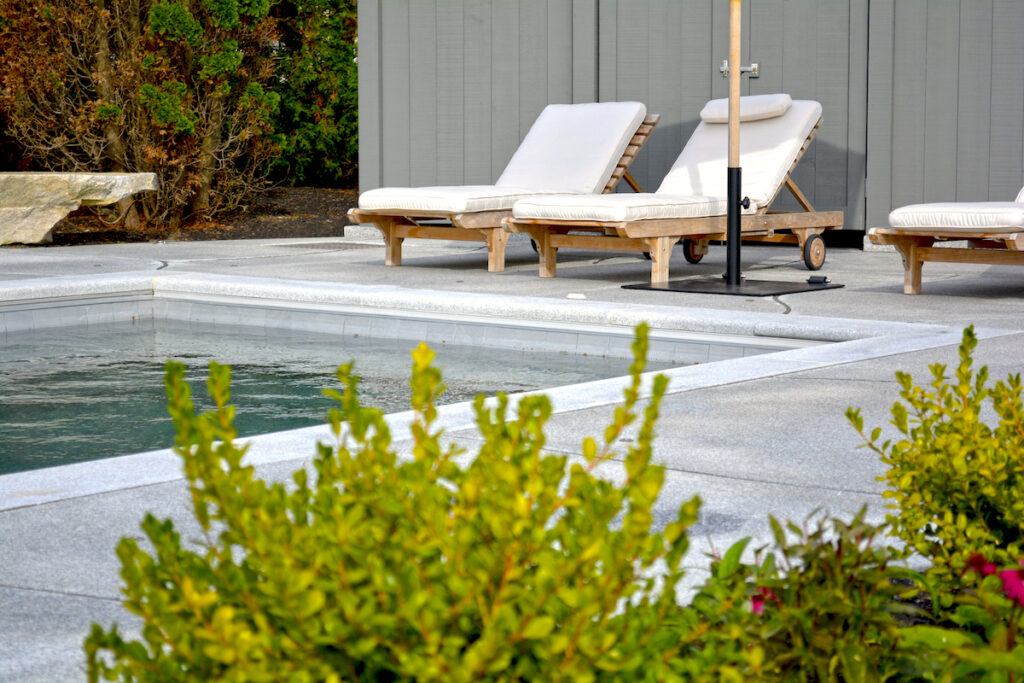
Polycor U
How To Add A Flamed Finish To Granite Surfaces
Create a unique slip-resistant finish that is long-lasting and durable with a flamed or thermal process. We’ll show you how!
Uncover a hidden beauty inside natural stone with the unique textured finish of a flamed surface! Learn all you need to know about flaming granite in our latest video course. Polycor experts demonstrate how to use this specialized technique to create slip-resistant surfaces ideal for high-end patios, walls and other exterior locations. See how an intense flame brings out an even texture that feels natural and produces a hard-wearing finish that will weather any environment. With the right knowledge, you can discover a new world of possibilities with flame-finishing stone and give your designs a modern aesthetic. Join us to learn how to flame granite and explore its unique beauty!
Course Description
Are you looking for ways to give your stone work a unique and stylish finish? In this video, we will demonstrate how to quickly and effectively make a flamed finish on stone products using a high heat torch. It’s an easy way to match the factory-finish texture and slip resistance to any granite surface, vertical or horizontal.
In this new Polycor U course you will learn:
- the right size tanks to use
- the proper pressure and mix of oxygen and propane
- how to adjust the flame to achieve adequate pre-heaters
- the technique for applying the flame to the granite surface
Flaming granite can be aggressive, so getting pressure and distances just right in the production phase is critical to creating a stone finish that is desirable and has a consistent feel. Let us show you how it’s done in our fabrication plants so you can replicate the process out in the field!
How to Create a Flamed Finish on Granite: Professional Thermal Finishing Techniques
Looking to elevate your stonework from ordinary to extraordinary? The flame finish granite technique offers a professional method for creating unique textures while adding essential slip resistance to granite surfaces. This thermal finishing process transforms smooth granite into beautifully textured stone with enhanced safety characteristics, making it perfect for both horizontal and vertical applications.
The flamed finish granite, also known as thermal finishing, represents one of the most dramatic surface treatments available for granite hardscaping projects. By applying intense heat to wet stone surfaces, this technique causes controlled surface expansion, revealing the natural beauty that lies beneath the polished exterior.
Understanding the Flaming Process
The science behind flame finishing relies on granite’s unique mineral composition. Granite contains various minerals—like quartz, feldspar, and mica—each with different thermal properties and expansion rates. When intense, concentrated heat is applied to a wet granite surface, these minerals expand at different rates, causing the surface layer to fracture and flake away in small, controlled pieces.
Professional contractors choose flame finish granite applications for their superior slip resistance and aesthetic appeal. “The flaming process works by exploiting the natural differences in thermal expansion between granite’s component minerals,” explains a stone fabrication expert. “When we apply high heat to the wet surface, the water turns to steam and helps pop off small pieces of stone, resulting in a smoothly textured and very consistent surface that you simply can’t achieve with mechanical methods.”
This process only works effectively with stones like granite and bluestone that contain minerals with varying expansion rates. Limestone and marble cannot be flamed due to their predominantly calcium carbonate composition, which responds uniformly to heat and doesn’t create the desired flaking effect.
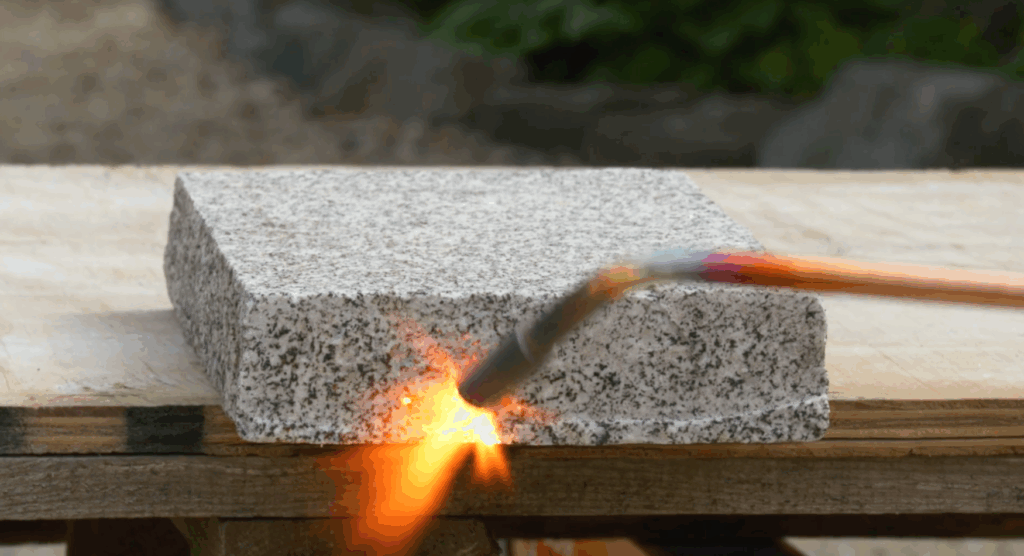
Essential Safety Equipment and Precautions
Safety represents the absolute top priority when performing flame finishing work. The combination of intense heat, flying stone fragments, and pressurized gas systems demands comprehensive protective equipment and careful adherence to safety protocols.
Required Personal Protective Equipment:
- Heat-resistant gloves rated for high-temperature work
- Safety glasses with Shade 5 rating for cutting applications
- Full face protection to guard against hot stone fragments
- Heavy canvas work apron for body protection
- Long-sleeved shirt and full-length pants
- Thick work boots with closed toes
- Fire-resistant clothing materials only
The intense heat generated during flaming causes hot stone chips to fly in all directions, making complete coverage essential. Never attempt this process without proper protective equipment, as burns from hot stone fragments can be severe and permanent.
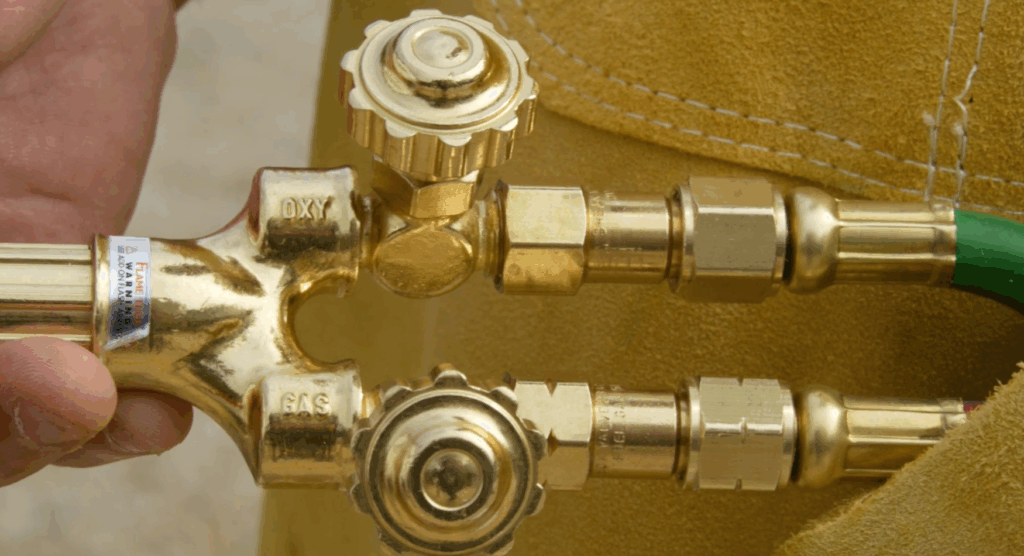
Equipment Setup and Gas System Requirements
Professional flame finishing requires a high-heat torch system connected to propane and oxygen tanks. The scale of your project determines the appropriate tank sizes—for substantial square footage, use 200 cubic feet tanks that provide adequate gas supply for extended work periods.
Critical Gas System Specifications:
- Minimum 100-pound oxygen tank for adequate flow and pressure
- Propane regulator rated for 60 psi minimum
- T-rated gas lines appropriate for the pressure requirements
- Propane gauge set to 20 psi initially
- Oxygen gauge set to 35 psi for optimal flame characteristics
Smaller tanks simply don’t provide sufficient flow and pressure for effective flaming. Most welding supply stores or sheet metal fabrication suppliers stock appropriate tanks and regulators. Ensure all connections are properly tightened and leak-tested before beginning work.
Workspace Preparation
The work environment requires careful preparation to ensure both safety and quality results. Position your granite workpiece on a stable, sturdy, non-flammable surface positioned lower to the ground for better control and safety. The stone will reach extremely high temperatures during the process, making proper support critical to prevent movement or cracking.
Thoroughly wet the stone surface before beginning, allowing water to absorb into the granite’s porous structure. This pre-wetting is essential for the flaming process—the water turns to steam upon heating, helping to fracture and remove the surface layer in the controlled manner that creates the desired texture.
Flame Application Technique
Light your torch by opening the propane valve and igniting the gas, then gradually add oxygen until achieving a blue flame with well-defined preheat areas. The proper mixture of oxygen to propane is crucial for effective results—too much of either gas will produce inefficient heating or dangerous operating conditions.
Proper Flame Application:
- Hold the flame close to the stone surface at a 25-45 degree angle
- Move smoothly and evenly across the surface
- Maintain consistent speed—not too slow to avoid overheating, not too fast to ensure adequate heating
- Watch for the granite surface to begin popping and flaking as the thermal effect takes hold
The visual feedback is immediate and obvious. You’ll see small pieces of the granite surface begin fracturing and flaking away, revealing the rough, textured finish beneath. This controlled destruction is exactly what creates the desired slip-resistant surface texture.
Edge Finishing Techniques
Stone edges require the same careful attention as face surfaces but demand modified technique for consistent results. When working edges, maintain the same flame angle and gas mixture but move in steady, consistent up-and-down patterns along the entire edge length.
Edge work often requires more time and attention than face surfaces due to the concentrated heat application area. Take care to maintain consistent movement to prevent overheating any single area, which could cause unwanted deep fracturing or color changes.
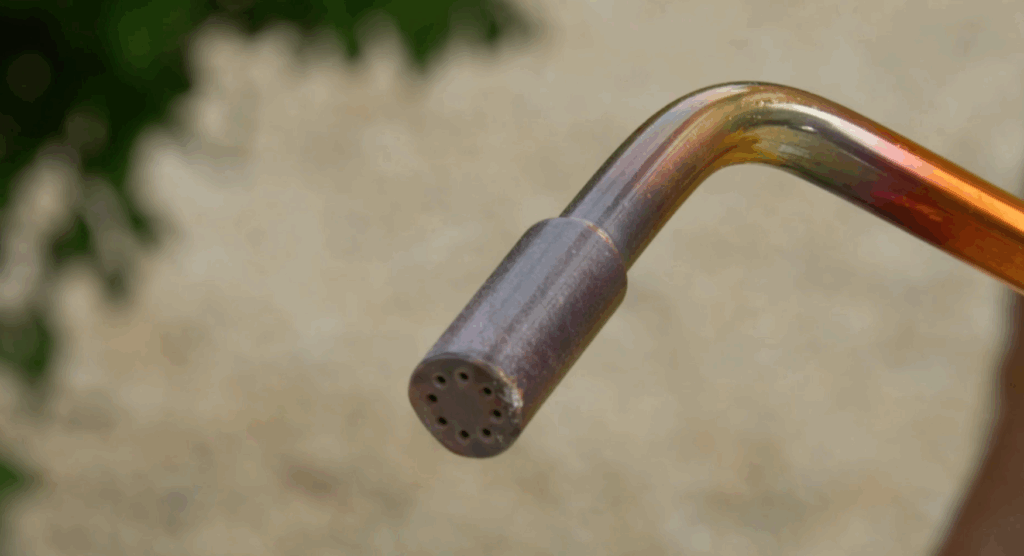
Achieving Desired Texture Depth
The intensity of the flamed finish can be controlled through multiple passes and heat application duration. For subtle texture, a single pass may suffice. More pronounced textural effects require additional passes, with each application creating deeper relief and more dramatic surface character.
“The beauty of flame finishing is its controllability,” notes an experienced stone craftsman. “You can create anything from a light texture that barely changes the stone’s appearance to deep relief that completely transforms the character of the piece. It’s all about understanding how your specific granite responds to heat and adjusting your technique accordingly.”
Allow adequate cooling time between passes to prevent over-stressing the stone structure. Rushed work often results in unwanted deep fractures or inconsistent surface appearance.
Color Transformation Effects
Beyond texture, flame finishing can dramatically alter stone colors depending on the granite’s mineral composition. Some granites develop warmer tones, while others may shift toward cooler hues. This color change is permanent and should be considered during project planning.
Testing on sample pieces or inconspicuous areas allows you to evaluate both texture and color changes before committing to large surface areas. Different granite varieties respond uniquely to flame finishing, making preliminary testing invaluable for predicting final results.
Applications and Design Benefits
Flamed finish granite surfaces excel in applications where slip resistance is paramount without sacrificing aesthetic appeal. Pool decks, exterior stairs, walkways, and commercial applications all benefit from the enhanced safety characteristics while maintaining the premium appearance that natural stone provides.
The modern aesthetic created by flame finishing makes it particularly popular in contemporary architectural applications. The consistent texture provides visual interest without the irregulararity of natural cleft or heavily textured surfaces, making it ideal for clean, geometric designs.
Professional installations often specify flamed finishes for high-traffic areas where both safety and appearance matter. The slip-resistant surface reduces liability concerns while delivering the sophisticated appearance that natural stone installations demand.
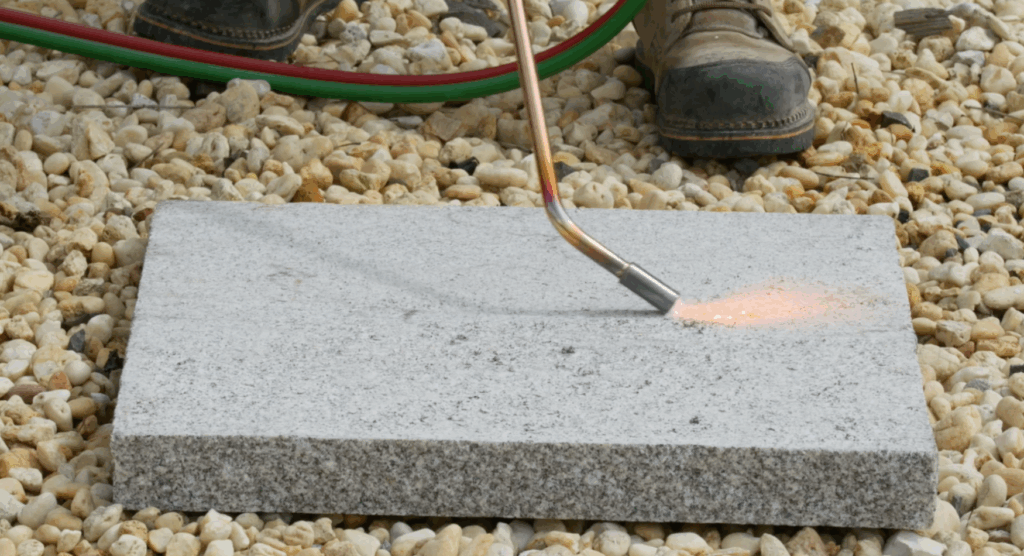
Professional Skill Requirements
While the basic technique can be learned, achieving consistent, professional-quality results requires understanding the nuances of different granite types, proper heat application, and pressure control. There’s a fine line between creating beautiful textured stone and damaging the material through excessive heat or improper technique.
“Understanding how different granites respond to heat application is something that comes with experience,” explains a master stone craftsman. “Each variety has its own characteristics, and learning to read the stone’s response to heat is what separates amateur work from professional results.”
The aggressive nature of flame finishing means that mistakes can’t be easily corrected. Proper pressure, distance, and movement speed must be mastered through practice and experience to create stone that meets professional standards with consistent finish quality.
Quality Control and Finishing
After completing the flame application, allow adequate cooling time before handling the stone. The textured surface should feel uniformly rough without areas of excessive depth or incomplete treatment. Properly flamed granite exhibits consistent texture depth and color throughout the treated area.
Clean the finished surface of any loose debris or stone particles that may have adhered during the cooling process. The final surface should be ready for installation without additional preparation, though some projects may benefit from light cleaning to remove any residual particles.
Maintenance and Longevity
Flamed granite surfaces require minimal maintenance while providing exceptional durability. The textured surface actually helps hide minor wear and weathering that might be noticeable on polished surfaces. Regular cleaning with appropriate stone cleaners maintains the appearance while preserving the slip-resistant characteristics.
The permanent nature of flame finishing means the texture and slip resistance will not wear away under normal use conditions. This makes it an excellent long-term investment for safety-critical applications where ongoing maintenance costs matter.
Transforming Your Stone Projects
Flame finish granite processing represents one of the most dramatic transformations possible in natural stone work. The technique turns ordinary polished granite into sophisticated textured surfaces that combine safety, beauty, and modern aesthetic appeal. Whether creating slip-resistant pool decking or adding contemporary flair to commercial installations, flame finishing offers possibilities that standard surface treatments simply can’t match.
Ready to add the distinctive character of flame finishing to your next granite project? Master this professional technique and discover how thermal finishing can elevate your stonework from ordinary to extraordinary, creating surfaces that are as safe as they are beautiful.
The investment in proper equipment and technique pays dividends through the unique textures and enhanced functionality that only flame finishing can provide. With practice and attention to safety, this traditional technique opens new possibilities for creating memorable stone installations that stand apart through their distinctive character and superior performance.


